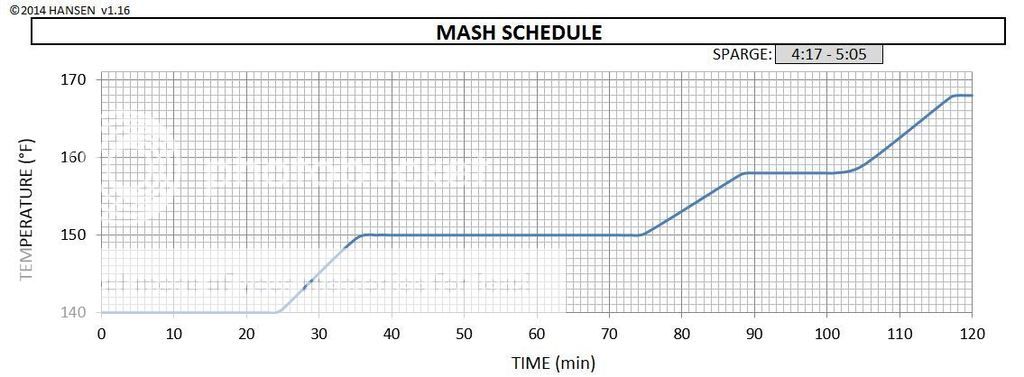Let me preface this by saying that I am sure your system has excellent mash temp control and makes great beer.
Thanks. With 6 years of (award winning) brewing on my eHERMS, it would appear so.
But, no, I really don't follow your logic. I don't understand your leap from controlling the HLT temp to controlling your mash temp. Yes, I get that you have a 4F delta between your HLT and the mash temp and that this is very consistent in your system.
Then what about this is confusing for you? Read that last sentence again.
In my system, my controller thermocouple sits right outside my mash tun. In my system, I set my controller 4F higher than my desired mash temp. I then measure my mash temp and the temp of the wort as it leaves the mash tun.
Now wait a minute. I thought you were advocating controlling the wort temp as it exits the HEX, as Dcpcooks described above.

If you're controlling your HLT PID via the wort temp as it leaves the MLT, then that's totally different from what I thought you were advocating here. Dcpcooks was advising OP to put the controlling temp probe at the HEX output, which is what I disagreed with, and the method that I thought you were defending here. It appears that our processes aren't
that different after all. Even your ΔT is the same.
Your particular method is much better than the HEX output method mentioned previously in this thread. In fact it's 90% the same as what I'm doing. I gotta say, I still don't prefer it over manually entering HLT temp, though. My reasons are simple, and we're speaking about preferences at this point, but hear me out if you want to understand this better. Look, ΔT between mash temp at equilibrium and the HLT is known. There's no point in using PID algorithms to find the right HLT temp when you
already know the right HLT temp based on the ΔT of your system. So, we've got a known ΔT, and a known HLT temperature required in order to maintain your desired mash temperature. Well, you know this delta, why not just
enter it? Tell the HLT what temp it should be, rather than asking a PID to figure it out! Why on earth would you want to leave it up to a PID to "find" this delta every time you brew? The only reason I could think of would be if you brew in a garage or somewhere seasonal and your losses vary from batch to batch, which would cause your ΔT to vary. Make sense yet?
I also know the exact temperature of the sparge water (and keep that temp PID controlled) throughout the lautering process. The same cannot be said for your method.
I do not understand why you think controlling your HLT temp is a more direct way of controlling mash temp. You are not controlling mash temp any more directly than I am. In fact, I would argue that your approach is more indirect.
That's not really a true statement, as I explained above. Listen, we are both ensuring
accurate mash temps at equilibrium, right? But your setup has looser control attributable to PID lag (which, of course, is only applicable during ramping, so this isn't a huge deal). Now that I know that you are
not using HEX output as your PID feedback, but instead your MLT output, I don't really have a huge objection to that. As you said, you set your temp to 4F above your desired mash. My delta happens to be exactly the same. We are basically doing the exact same process; we are just
controlling it slightly different. I manually set my HLT PID to 4F above desired mash temp and quickly and accurately reach my temps, while you on the other hand, are asking your PID to use MLT exit temp as its feedback, which doesn't afford you as "tight" of a control, but will still accurately maintain your mash temp. Once temperature is reached on both our setups, both are plenty accurate. Am I making sense to you yet?
The only way to be more direct than my approach is to put the controller thermocouple in the mash itself.
Well, again not true. Wrong direction. You're too fixated on the "controlling" aspect and terminology. A PID isn't always the best way to control a system parameter, in fact it actually puts you at an ever so slight disadvantage over manually entering the HLT temp when you're ramping your mash (so long as your ΔT is constant). Again, not a huge deal. Listen, on one hand you have a known value, and you can enter it to maintain a process parameter. On the other, you have a known value, but you still ask a PID to figure that value out each time you brew...to maintain a process parameter. See? Both methods work. I like mine better because I'm a process oriented engineer turned brewer/brewing adviser. I'm not telling you that your method is wrong. I just have the control I need from my system to control the process the way I want. It works very well and I've been happy with it since I built it in 2010.
Anyway, I've used up my patience on this topic for now. If you have
specific questions, shoot away. Otherwise, we can get back to brewing our (slightly) different ways. Cheers, bud.




















































![Craft A Brew - Safale S-04 Dry Yeast - Fermentis - English Ale Dry Yeast - For English and American Ales and Hard Apple Ciders - Ingredients for Home Brewing - Beer Making Supplies - [1 Pack]](https://m.media-amazon.com/images/I/41fVGNh6JfL._SL500_.jpg)





